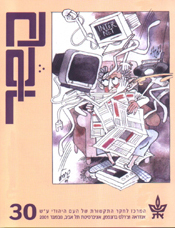|

Rudi Weissenstein:
Photographer of the Declaration of the State of Israel
Von Shlomo Sheva
The manufacture in Germany of small, high-quality
portable cameras at the end of the 1920s engendered the emergence of
photo-journalism – a series of photos that told the story of an event or an
experience. Many of the founders and leading photographers of this genre
were Jews, such as Erich Salomon, who photographed Europe’s heads of state,
diplomats and other personalities in unexpected moments; and Alfred
Eisenstadt, who was to become a founder of Life magazine. With the
rise of Hitler, the Jewish photo-journalists were forced to flee.
More than other professionals in the arts who left
Germany, Jewish photo-journalists were able to find both refuge and a
livelihood in Eretz Yisrael then. Language was not essential for
photographers. At the same time, the major Jewish institutions in the
country – the Jewish Agency, the Jewish National Fund, Keren Hayesod, the
Histadrut and other public bodies sought photographers to publicize their
projects throughout the world. Such well-known photo-journalists as Helmar
Larski, Tim Gidal, Walter Zedek, Zoltan Kluger, Hans Pinn and Rudi
Weissenstein produced high-level journalistic photography in Eretz Yisrael
during the 1930s.
They were not press photographers, for the local
newspapers lacked the technical means and the funds to use photos. However,
they were international photo-journalists, for they documented newsworthy
developments in Eretz Yisrael that were publicized throughout the world.
Such developments were not lacking: the building of new settlements, violent
riots, the arrival of immigrants from Europe, and the unfamiliar Arab
milieu.
The photos also documented the Zionist agenda, and in this
sense they were "commissioned" photos, parallel to the Soviet-produced
photographs that were commissioned to glorify Communism. Yet, they may also
be compared to the photos of the great depression in the U.S., which were
commissioned by the government to serve social needs.
Rudi Weissenstein, born in Czechoslovakia in 1910, studied
photography in Vienna and became a press photographer for a Prague
newspaper. Arriving in Eretz Yisrael in 1936, he was immediately
commissioned by various institutions to take pictures and within a few
months time produced a body of documentary work of distinction.
That same year, violinist Bronislaw Huberman gathered
Jewish musicians who had fled the Nazis and established the Palestine
Philharmonic. The opening concert, conducted by the legendary Arturo
Toscanini, nearly ended in disaster when a photographer used a flash to
photograph Toscanini in the middle of a piece, prompting the infuriated
maestro to walk off the stage. Only after considerable coaxing did he
consent to return, and the event ended in success. Meanwhile, Weissenstein,
unnoticed, caught Toscanini and Huberman in a series of rare candid photos
using his small, flashless camera, producing some of his most unforgettable
portraits. From then, he served as the Philharmonic’s photographer for a
period of 40 years.
He photographed the international Levant Fair held in Tel
Aviv in 1936, and the opening of the Tel Aviv port soon thereafter.
Throughout the period of the Arab riots of 1936-39 he photographed the
establishment of new settlements, the arrival by ship of European children
as part of the Youth Aliyah rescue effort, and the clandestine arrival of
other ships with “illegal” immigrants fleeing Europe, hastily disembarking
at the Tel Aviv shore before they could be caught by the British police.
With the outbreak of World War II, the institutional
demand for photos of Eretz Yisrael declined. Weissenstein and his wife,
Miriam, opened a photography shop in Tel Aviv opposite the Mograbi Theater,
while he continued photographing the city and its people. Only in 1948,
during Israel’s War of Independence, did the local press begin to run photos
of events and use press photographers. Weissenstein photographed everything
that came his way, but people were his deepest interest. Over the years, he
photographed all the leaders of the country at various stages of their
lives, thereby compiling a documentary record of the history of the country.
Perhaps his most notable achievement was the request he
received to photograph the ceremony of the declaration of the state, which
took place on May 14, 1948, at the modest Tel Aviv Museum on Rothschild
Boulevard at the height of the War of Independence. He took some 30 photos
of the event, including photos of the crowd waiting outside, images that are
well known to this day.
He continued to photograph for many years. Ambitious young
politicians knew that to be photographed by Weissenstein meant to have
arrived. His work was shown in exhibitions in Israel and abroad. He was
admired by the young generation of photographers not only for his skill but
for his gentlemanly manner. He died in 1992. His shop still stands in its
old location, run by the energetic Miriam, the faces of the founders of the
state still peering out of its display windows.
Kesher, No. 30, November
2001
Bestellen?
|